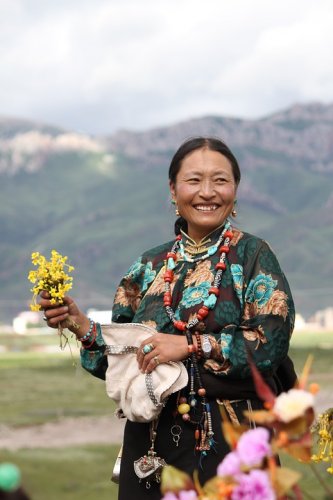Denisovan DNA May Explain Why Tibetan Women Thrive In Low Oxygen At High Altitudes For Over 10,000 Years
Conny Waters - AncientPages.com - Breathing in the thin air found at extreme altitudes poses a considerable challenge due to the reduced oxygen available with each breath. Remarkably, Tibetan women residing on the high Tibetan Plateau have not only survived but thrived in such conditions for over 10,000 years. This phenomenon has intrigued scientists for some time, and a recent study has provided valuable insights into this mystery.
Background: View of a Tibetan village from the Himalayas. Credit: James Yu. DNA - Credit: Adobe Stock - Great Choice - A preliminary portrait of a juvenile female Denisovan based on a skeletal profile reconstructed from ancient DNA methylation maps. Credit: Maayan Harel - Image compilation Ancient Pages
It seems that Denisovan DNA—originating from those who lived in Siberia around 50,000 years ago—plays a crucial role in understanding human evolutionary adaptation. Additionally, there are several other factors that contribute to how humans adjust to consistently low oxygen levels both in their environment and within their bodies.
Humans Adapting In Extreme Environment
The findings, Beall said, not only underscore the remarkable resilience of Tibetan women but also provide valuable insights into the ways humans can adapt in extreme environments. Such research also offers clues about human development, how we might respond to future environmental challenges, and the pathobiology of people with illnesses associated with hypoxia at all altitudes.
"Understanding how populations like these adapt," Beall said, "gives us a better grasp of the processes of human evolution."
Beall and her team studied 417 Tibetan women, aged 46-86, living at altitudes of 12 000 to 14 000 feet in Upper Mustang, Nepal. The research explored how oxygen delivery traits affect reproductive success in hypoxic environments. They collected data on the women's reproductive histories, physiological measurements, DNA samples, and social factors.
Their findings showed that women with the most live births had unique blood and heart traits enabling efficient oxygen delivery. They had average hemoglobin levels but higher oxygen saturation, allowing effective cell oxygen transport without increasing blood viscosity, which can strain the heart.
"This is a case of ongoing natural selection," said Beall, also the university's Sarah Idell Pyle Professor of Anthropology. "Tibetan women have evolved in a way that balances the body's oxygen needs without overworking the heart."
Genetic Trait From Denisovans
Researchers have identified a fascinating genetic trait that likely traces its roots back to the Denisovans, an ancient group of hominins who lived in Siberia approximately 50, 000 years ago.
This group shared the planet with other archaic humans like Neanderthals and Homo sapiens. Over time, their descendants embarked on a significant migration that led them to the high-altitude Tibetan Plateau, a region characterized by its challenging environmental conditions.
Tibetan woman. Credit: Pixabay - jarryyi - Public Domain
A particularly interesting discovery among these populations is a variant of the EPAS1 gene. This gene variant is rare and distinctive to native inhabitants of high-altitude regions such as Tibet. The EPAS1 gene plays an essential role in managing hemoglobin concentration—a crucial factor for survival in areas where oxygen levels are perpetually low due to thinner air. By regulating hemoglobin efficiently, individuals with this genetic trait can maintain adequate oxygen transport throughout their bodies despite the reduced atmospheric oxygen availability.
In addition to this genetic adaptation, there are other physiological traits observed in these populations that further enhance survival at high altitudes. For instance, increased blood flow directed towards the lungs helps optimize oxygen uptake during respiration. Wider heart ventricles enhance circulation, efficiently delivering oxygen-rich blood throughout the body.
These remarkable adaptations have enabled these communities not only to survive but also thrive on the Tibetan Plateau by contributing significantly to greater reproductive success over generations. Studying these adaptations offers insights into human evolution and how our species adjusts to low-oxygen environments.
The study was published in the journal Proceedings of the National Academy of Sciences
Written by Conny Waters - AncientPages.com Staff Writer






















